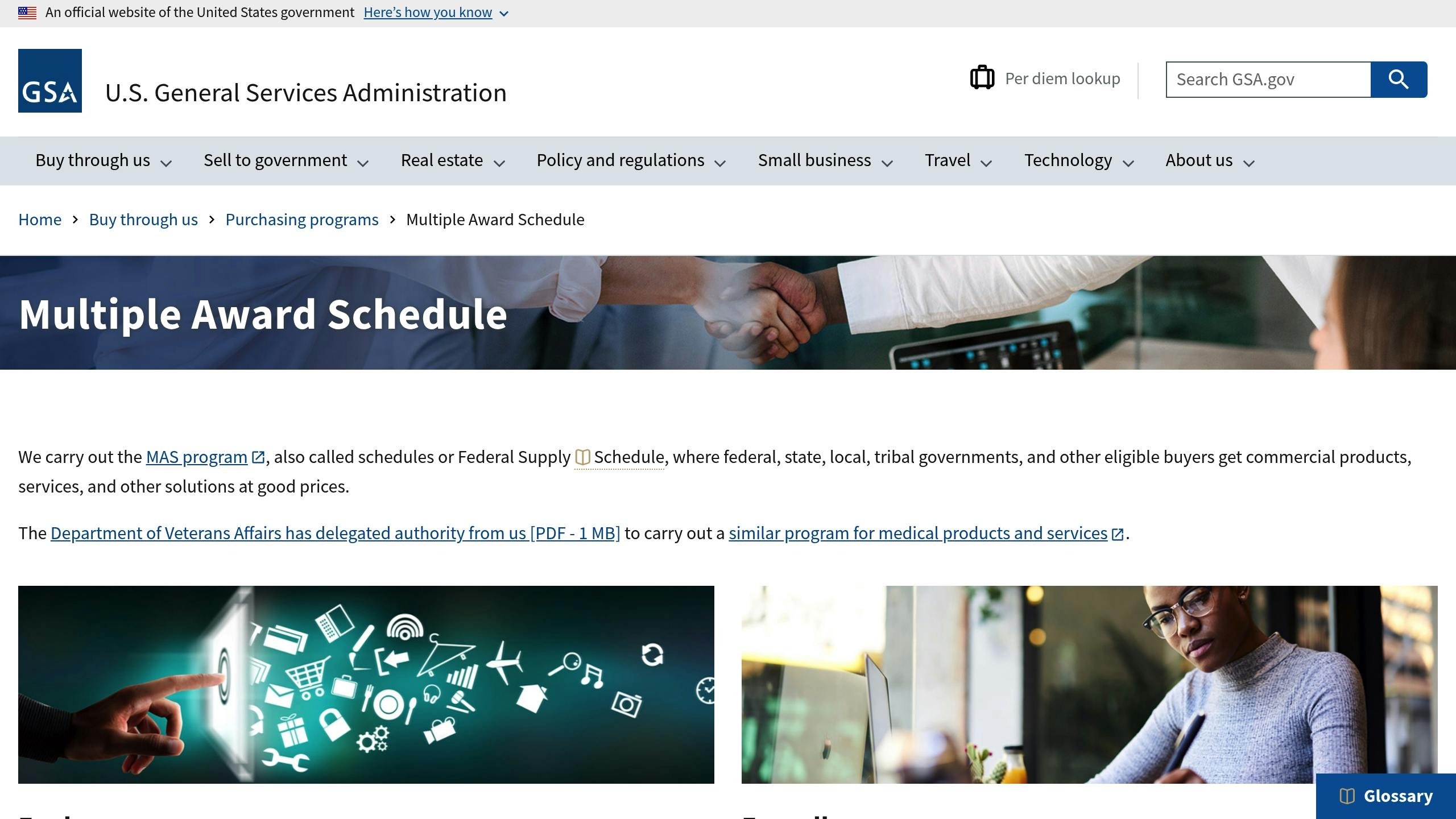Every day, businesses miss out on over $50 million in federal contracting opportunities through GSA Schedule contracts. Why? Misaligned resources and lack of preparation. Here’s what you need to know:
Key Takeaways:
- GSA Market Size: $45 billion in 2023, with $160 million in daily opportunities.
- Participation Gap: Only 4% of small businesses are part of the GSA program.
- Benefits: Shorter sales cycles, consistent revenue, and reduced competition.
- Expert Help vs. DIY:
- Expert support cuts time from 100+ to 3 hours and achieves a 98% success rate.
- DIY is 4–6× slower and less effective.
Quick Comparison:
| Approach | Time Investment | Success Rate | Revenue Impact |
|---|---|---|---|
| Expert Support | ~3 hours | 98% | ~$927,000 boost |
| DIY | 100+ hours | Low | Limited opportunities |
To succeed, align your resources wisely – build a team, use the right tools, or outsource to experts like GSA Focus.
How to Succeed with GSA Schedule Contracts

Research Findings on Resource Planning
Recent studies shed light on how businesses approach resource planning, particularly in managing GSA Schedule contracts, and the outcomes of their investments.
Team Structure Options
Businesses tackle GSA Schedule contracts in different ways. Some create dedicated teams focused exclusively on GSA operations, while others assign these tasks to existing departments. Each approach has its own challenges and benefits, depending on the company’s size and goals.
Resource Distribution Methods
How companies allocate resources plays a big role in securing contracts and managing them effectively.
"Every day you’re not on GSA, you’re missing out on $50m+ in opportunities." – Josh Ladick, Founder of GSA Focus
There are two main ways businesses handle resource allocation:
-
DIY Approach
This option involves a lot of internal effort, requiring over 100 hours for paperwork and documentation preparation. -
Outsourced Solution
Companies that hire professionals, such as GSA Focus, cut their time investment down to about 3 hours, making the process four to six times faster than doing it in-house.
The choice between these methods can significantly impact both time and efficiency.
Investment Results
Strategic resource allocation directly affects business outcomes. Companies that invest in GSA expertise and reliable support systems often see better results, as highlighted by the following metrics:
| Investment Outcome | Measured Impact |
|---|---|
| Revenue Increase | $927,000 average boost to the bottom line |
| Success Rate | 98% contract approval rate with expert help |
| Return on Investment | 87x average ROI with a structured approach |
| Market Entry | 57% of successful applicants were new to government contracting |
These numbers highlight the importance of careful planning and smart resource allocation. While the upfront costs might seem high, the long-term rewards – higher revenue, better approval rates, and easier market entry – make it a worthwhile investment in the competitive GSA landscape.
sbb-itb-8737801
Small Business Implementation Steps
GSA Team Development
Building a strong GSA team is crucial, especially considering that only 4% of small businesses successfully secure GSA Schedule contracts. Small businesses often encounter two main hurdles when forming their GSA teams:
- Internal Skills Gap: Many teams lack the expertise to navigate changing GSA requirements.
- Resource Constraints: Managing the extensive documentation required can be overwhelming.
To overcome these obstacles, businesses can either invest in developing in-house expertise or collaborate with specialists, depending on their resources and long-term goals. Additionally, having the right tools and software is key to maintaining compliance and streamlining processes.
Required Tools and Software
Once a capable team is established, the next step is implementing the right tools and software. Research indicates that successful small businesses typically rely on the following:
| Tool Category | Purpose | Impact on Operations |
|---|---|---|
| Document Management | Organize contracts and control document versions | Avoids issues with lengthy form updates |
| Compliance Tracking | Monitor and uphold GSA requirements | Ensures continued program compliance |
| Client Management | Manage federal customer relationships | Supports revenue opportunities averaging $927,000 |
GSA Focus: A Done-for-You Solution

For small businesses looking to ease the workload and increase their chances of success, GSA Focus provides a comprehensive solution. Their process directly addresses the common challenges faced by small businesses:
"GSA Focus is the fastest, easiest, and best way to get a GSA contract." – GSA Focus
GSA Focus reduces the time commitment to around 3 hours, achieves a 98% contract approval rate, and helps 57% of first-time contractors secure federal contracts. Their services cover document preparation, compliance management, and negotiation support, allowing businesses to focus on their core operations while experts handle the complexities of GSA requirements.
Common Problems and Solutions
Meeting Compliance Rules
Managing compliance can be a major challenge for businesses, often leading to operational headaches. Here are some common hurdles and ways to tackle them:
| Challenge | Impact | Solution |
|---|---|---|
| Documentation Management | Over 100 hours spent on paperwork | Use document management systems or hire experts |
| Regulatory Updates | Constant policy changes disrupt compliance | Invest in compliance tracking tools or services |
| Contract Negotiations | Complex pricing and terms to navigate | Seek professional negotiation assistance |
Given the strict requirements set by the federal government, many businesses turn to external support. For instance, companies working with specialized providers like GSA Focus have a 98% success rate in securing GSA contracts. Compare that to the mere 4% success rate for small businesses going it alone. Clearly, finding efficient ways to handle these challenges is critical.
Limited Resource Solutions
Small businesses often struggle with limited resources when it comes to managing GSA contracts. However, research shows that some strategies can make a big difference:
- Outsource Complex Tasks: Handing off time-consuming GSA tasks to specialists can reduce workload from more than 100 hours to just 3 hours while delivering a much better return on investment (ROI). On average, businesses see an ROI of 87x, adding nearly $927,000 to their revenue.
- Prioritize Internal Efforts: Focus your team’s energy on client satisfaction and service delivery instead of administrative tasks.
- Use Ready-Made Solutions: Done-for-you options can be 4–6× faster than trying to handle everything in-house.
Conclusion
Main Findings Summary
Research indicates that aligning resources effectively is key to achieving success with GSA contracts. Currently, only 4% of small businesses participate in GSA Schedules, highlighting both the challenges and untapped opportunities in this market.
Here’s a quick breakdown of strategies and their outcomes:
| Strategy | Impact | Outcome |
|---|---|---|
| Expert Support (GSA Focus) | 87x ROI | 98% success rate |
| DIY Approach | 4–6 times slower processing | 4% participation rate |
| Outsourced Management | ~$927,000 revenue potential | Competitive edge in a limited-bid market |
Getting Started
To make the most of these insights, start by evaluating your resources and planning strategically.
"Every day you’re not on GSA, you’re missing out on $50m+ in opportunities." – Josh Ladick, Founder of GSA Focus
- Evaluate Current Resources: Determine your team’s capacity to handle GSA requirements while keeping regular operations on track.
- Consider Time Investment: Professional assistance can speed up the process by 4–6 times.
- Leverage Expert Support: Expert guidance leads to a 98% success rate in securing contracts.
Allocating resources wisely – whether by building internal expertise or seeking outside help – is critical for tapping into the $45 billion annual GSA Schedule program.
Related Blog Posts
- How to Find Target Agencies for GSA Contracts
- How to Manage GSA Contract Performance
- GSA Award Process Explained
- Ultimate Guide to Federal Subcontracting Strategies


